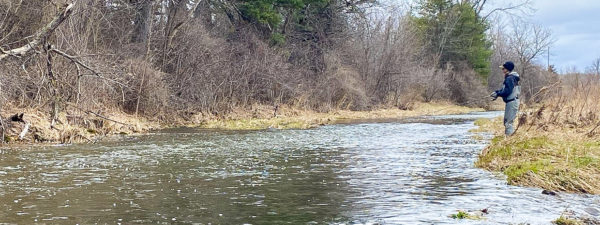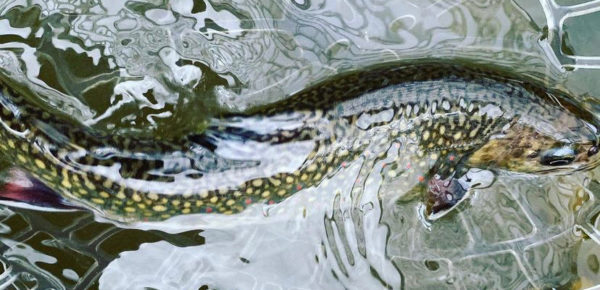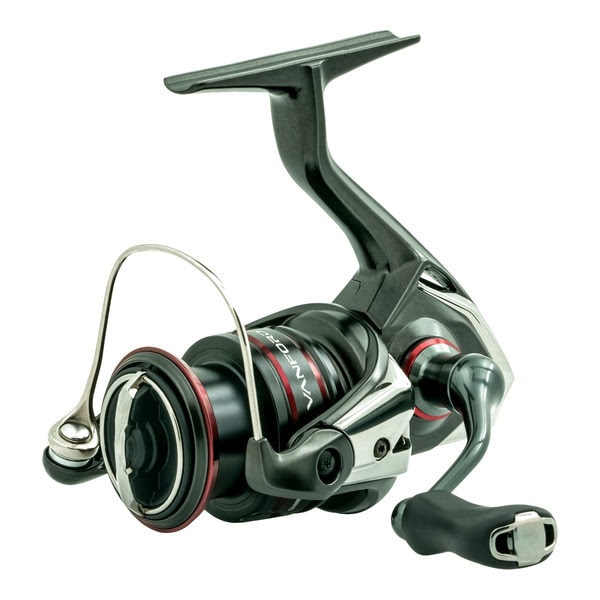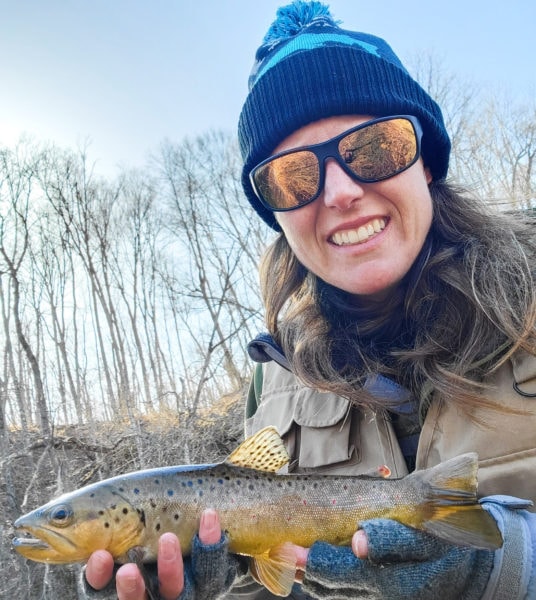Read Water and Reduce Line Drag to Catch More Stream Trout
Category: article
May 5th, 2022 by Keith Worrall
Modified May 5th, 2022 at 10:08 PM
Achieve Drift Perfection
Read Water and Reduce Line Drag to Catch More Stream Trout
By Kristine Ostertag
“Eventually all things merge into one, and a river runs through it”- Norman Mclean
Standing on the bank of a river with the sun shining, the water rushing and trout rising embodies serenity. A lucky few – the stream trout specialists – know this setting and can close their eyes to see it, hear it, and smell it. I was blessed to grow up in the Driftless Area of Wisconsin, a region untouched by glaciers during the last Ice Age and now home to some of the most beautiful, productive, and technical trout water in the Midwest. As I wade these streams in pursuit of the stunning browns, brookies, and the occasional rainbows that swim there, I am reminded of the challenges that anglers must overcome to succeed in this setting – and the time-tested techniques that will help them to do so.
No single aspect of stream trout presentation is more important than achieving the perfect drift. Regardless of the bait you select, the colors or patterns you choose, or the spots you plan to focus on, the perfect drift – which refers to the most natural lure delivery possible – keeps your offering in the strike zone longer and helps you land more fish. Before you can create that perfect drift, however, you must be able to read the water and understand the behaviors of trout as they relate to their environment.

A typical segment of a trout stream – beginning with a shallow, bubbly, high-current area and ending with a slow, deep pool – can actually be divided into five distinct sections. The shallow, rocky area with relatively fast current is called the riffle, which is highly oxygenated and a good place to find actively feeding trout. Below the riffle is the run – also a good place to fish – where the water starts to get deeper and the current becomes more uniform. Trout will sit adjacent to the current, waiting for food to come to them in the run. Drifting baits along current seams in the run will put you in the target zone for hungry trout. The pool, where the water deepens and the current slows further, follows the run. Bright sunshine will cause trout to move into pools, which provides a degree of shelter from the sun and from predators. Trout in pools are often harder to catch due to their generally reduced activity levels. In addition, many of the larger fish in any given stream section will often position themselves in deep pools. Don’t overlook eddys, which are areas of gently swirling current adjacent to deep water in pools. Eddys will trap insects and other prey items, which makes for an easy meal for any nearby trout. The tailout – the end of the pool – is the last distinct stream section. Here, the water is still deep but starts to become shallow as the bottom rises. Current accelerates here, while still being slow enough for trout to easily position themselves in feeding lanes, rising to sample bugs in the drift. Every trout stream will have segments just like this, often peppered with fallen trees, undercut banks, or submerged vegetation that can also hold trout.

Eliminating line drag is central to achieving the perfect drift, especially in the riffle, run, and tailout stream sections. These are the key sections that hold active, feeding trout and also where current interactions with the line can be most significant. Whether you are a fly angler presenting a dry or wet fly, or a spinning gear specialist throwing jigs, small spinners, or micro crankbaits, minimizing the amount of line that is in – or on – the water will minimize drag and achieve a natural drift. Learning to mend your line, which maintains slack upstream of the lure rather than downstream of it, is important when presenting lures or flies at the end of a long cast so that artificial offerings move at the same speed as the local current. Using a longer rod will help keep as much line out of the water as possible and help you achieve drift perfection. Fly anglers facing technical stream challenges will appreciate the 7’9”, 4-weight G. Loomis IMX-PRO Creek (IMX-PRO C 479-4) rod.

Lightweight and durable, rods in the IMX-PRO Creek series load short and track true, making them incredibly versatile across a wide range of stream trout scenarios. Spinning specialists connect with stream trout success using a light power G. Loomis Trout Series rod (TSR 862-2). This 7’2” rod has fast action for the ultimate in control, whether you’re pitching a spinner, a marabou jig or drifting single eggs on your favorite stream. Complement the performance of the G. Loomis Trout Series rod with a 1000-series Shimano Vanford (VF1000F) spooled with 6 pound-test monofilament. Whether you rely on spinning or fly tackle on your favorite moving waters, using finely-tuned equipment that perfectly addresses the challenges of stream trout fishing will help you achieve the perfect drift and catch more fish.

Shimano Vanford 1000
We want trout to encounter our flies or lures in the same way that they naturally encounter prey, so casting upstream and drifting baits downstream to the fish is optimal. Clear water may make this challenging, so stay low, keep your distance, and be mindful of where your shadow hits the water. Finally, do your best to match the hatch. Trout will often lock-in on one particular silhouette or color, so take a moment to observe the type and size of any submergent or emergent insects – or other prey items like small minnows or scuds – before you make your first cast. The right lure or fly, presented on the perfect drift, is truly the key to stream trout success.

Kristine Ostertag
______________________________________________________________________________
About the author
Kristine Ostertag grew up in rural Wisconsin and was raised on the water and in the woods. She is passionate about the outdoors and spends each and every spare moment chasing something with fins, fur, or feathers. Follow along with Kristine’s outdoor adventures on Instagram @sportswomankristine [email protected].
